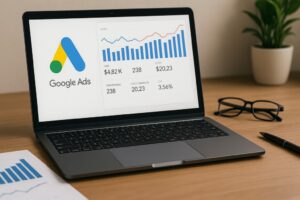Running your own Google Ads campaigns seems straightforward at first. Write some ads, pick keywords, set a budget, and watch the leads roll in. But after a few weeks of mediocre results and rising costs, reality sets in. Writing effective ad copy that actually converts takes more skill than most business owners realize.
The difference between amateur and professional ad copy isn’t just about grammar or creativity. It’s about understanding buyer psychology, search intent, and the complex relationship between what people search for and what actually makes them click. Most DIY campaigns fail not because the products or services are bad, but because the ad copy doesn’t connect with what potential customers are really looking for.
The Hidden Complexity of Ad Copy That Converts
Good Google Ads copy does way more than describe your business. It needs to match search intent, differentiate from competitors, address specific pain points, and create urgency – all within character limits that would make Twitter jealous. That’s a lot to pack into 30 characters for a headline and 90 for a description.
Here’s where most business owners get stuck. They write ads that sound good to them, but they’re not thinking like their customers. A plumber might write “Professional Plumbing Services” because it sounds professional and covers everything they do. But someone with a burst pipe at 2 AM is searching for “emergency plumber near me” and wants to see words like “24/7” and “fast response” in the ad copy.
The problem gets worse when you factor in different customer types. The same plumbing business might need completely different ads for someone planning a bathroom renovation versus someone dealing with an emergency. Same business, but totally different emotional states and decision-making processes.
Professional copywriters understand these nuances because they’ve tested thousands of variations and seen what works across different industries and customer segments. When experts focus on creating effective ad copy, they’re drawing from data and experience that most business owners simply don’t have access to.
When DIY Ad Copy Starts Costing Money
The biggest red flag is when your click-through rates stay consistently low. If less than 2% of people who see your ads are clicking on them, your copy probably isn’t resonating with your audience. Low click-through rates don’t just mean fewer visitors – they also hurt your Quality Score, which makes your ads more expensive over time.
Another warning sign is getting clicks but no conversions. This usually means your ad copy is attracting the wrong people or setting unrealistic expectations. Maybe your ads promise same-day service when you actually need 48 hours, or they emphasize low prices when your business model is based on premium quality.
High cost-per-click compared to competitors is another indicator. If you’re paying significantly more than industry benchmarks for the same keywords, it could be because your ad copy isn’t compelling enough to earn high Quality Scores. Google rewards relevant, well-written ads with lower costs and better positioning.
This is where it gets expensive fast. A business spending $3,000 per month on ads with poor copy might get the same results that professional copy could deliver for $1,500. Over a year, that’s $18,000 in wasted spend – more than enough to pay for professional management.
The Strategic Thinking Behind Professional Ad Copy
Professional Google Ads managers don’t just write individual ads. They create ad ecosystems that work together across different stages of the customer journey. Someone searching for “accounting software comparison” needs different messaging than someone searching for “QuickBooks alternative” even though both might be potential customers for the same product.
They also understand ad extensions and how to use them strategically. Sitelinks, callouts, and structured snippets aren’t just extras – they’re opportunities to include additional selling points and take up more space in the search results. But they need to complement the main ad copy, not compete with it or repeat the same information.
Testing is another area where professionals have huge advantages. They know how to structure A/B tests that actually provide useful insights, not just random data. They test specific elements systematically – headlines against headlines, calls-to-action against calls-to-action – rather than completely different ads that make it impossible to know what drove the performance difference.
Professional managers also stay current with Google’s constantly changing ad formats and policies. Responsive search ads, for example, require a completely different approach than traditional expanded text ads. The algorithm needs multiple headline and description options to test, but they need to work well in any combination.
The Economics of Professional Management
Most professional Google Ads management services charge between 15-20% of ad spend, with minimum monthly fees typically ranging from $1,000 to $2,500. For a business spending $5,000 per month on ads, that means paying $750-1,000 for management.
That might seem expensive until you consider what professional management actually delivers. Better ad copy typically improves click-through rates by 25-50%, which directly reduces costs through improved Quality Scores. Professional keyword research and negative keyword management can eliminate 20-30% of wasted spend on irrelevant clicks.
The conversion rate improvements often provide the biggest impact. Professional landing page optimization and ad copy that properly sets expectations can double conversion rates in some cases. Even a 25% improvement in conversion rate means 25% more customers for the same ad spend.
When you factor in the time savings, the economics become even more compelling. Most business owners spend 10-15 hours per week managing their campaigns poorly. That’s time that could be spent on actual business development, customer service, or product improvement.
What to Look for in Professional Management
Not all Google Ads management services are created equal. Look for providers who ask detailed questions about your business model, profit margins, and customer lifetime value before proposing any strategies. They should want to understand your sales process and how leads convert into customers.
Good managers will also explain their testing methodology and show you examples of how they’ve improved similar campaigns. They should be able to walk you through their account structure approach and explain why they organize campaigns the way they do.
Avoid services that promise specific results like “guaranteed 300% ROI” or “first page rankings for any keyword.” Google Ads performance depends on too many variables – competition, market conditions, product quality, pricing – for anyone to make legitimate guarantees about specific outcomes.
Making the Transition from DIY to Professional
If you decide to work with a professional service, don’t expect overnight transformations. Good managers typically need 60-90 days to fully optimize an account, especially if the previous campaigns were poorly structured.
The transition period involves auditing existing campaigns, researching new keyword opportunities, rewriting ad copy, and restructuring account organization. This foundational work isn’t glamorous, but it’s necessary for long-term success.
During this period, expect some performance fluctuations as new campaigns are tested and optimized. Professional managers should communicate what they’re changing and why, so you understand what’s happening behind the scenes.
The Long-Term Value Equation
The real value of professional Google Ads management isn’t just better immediate performance – it’s building sustainable, scalable advertising systems that grow with your business. Professional managers create documentation, processes, and account structures that continue delivering value over time.
They also stay ahead of platform changes and new opportunities. When Google releases new ad formats or targeting options, professional managers can quickly evaluate and implement them rather than letting competitors gain months of advantage.
The key is finding a service that views Google Ads management as a strategic partnership rather than just a tactical execution. The best results come when professional managers understand your business deeply enough to suggest improvements beyond just ad copy – landing page optimization, conversion tracking enhancement, and integration with other marketing channels.
For most businesses spending more than $2,000 per month on Google Ads, professional management pays for itself through improved efficiency and better results. The question isn’t whether you can afford professional help – it’s whether you can afford to keep wasting money on campaigns that underperform because the fundamentals aren’t right.








